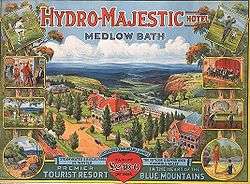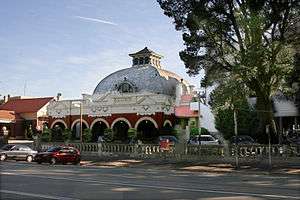Hydro Majestic Hotel
| Hydro Majestic Hotel | |
|---|---|
|
Hydro Majestic Hotel Casino dome in 2007 | |
| General information | |
| Location | 52 – 88 Great Western Highway Medlow Bath, New South Wales, Australia |
| Coordinates | 33°40′32.85″S 150°16′51.08″E / 33.6757917°S 150.2808556°ECoordinates: 33°40′32.85″S 150°16′51.08″E / 33.6757917°S 150.2808556°E |
| Opening |
1891 (Belgravia Hotel) 1904 (Hydro Majestic) |
| Website | |
| http://www.hydromajestic.com.au/ | |
The Hydro Majestic Hotel is located in Medlow Bath, New South Wales, Australia. The hotel is located on a clifftop overlooking the Megalong Valley on the western side of the Great Western Highway.
The hotel is heritage listed and is notable for its unusual mix of architectural styles, including Art Deco and Edwardian. One key feature is the Casino dome (pictured). The dome was bought in Chicago and shipped to Australia, before being shipped to the Blue Mountains by bullock train and reassembled at the site.[1]
History

The Australian retailer Mark Foy began to purchase the site in 1902 for the purposes of a hydropathic sanatorium under the belief that the land contained mineral springs.
The Hydro Majestic site was originally three different land holdings and their buildings. The first was the country retreat of W.H. Hargraves, registrar in Equity and a trustee of the Australian Museum in Sydney, son of the man who claimed credit for the discovery of gold in New South Wales in 1851. The single-storey house, with elaborate tree and shrub plantings, was bought by Mark Foy in 1901 and developed into the Hargravia section of the Hydro.[2]
The second was the hotel. It began as the Belgravia Hotel which was completed in 1891. The hotel was a health retreat and the building was constructed in Queen Anne style. It was owned and operated by Mr and Mrs Ellis and was acquired by Mark Foy in 1903.[3]
The third was a cottage owned by Alfred Tucker, whose widow later ran the Wonderland Park guesthouse to the north of the gatekeeper’s cottage.[4] At that stage the town was known as "Medlow" and Mark Foy successfully petitioned the New South Wales government to change the name to Medlow Bath, the current name.[5] It is not known if he requested the name change to make it sound more prestigious, or if he wanted to avoid confusion with another town called Medlow, also in New South Wales.
Foy spared no expense, building gardens, bringing in his own herd of cows for milk and, not a man to be bested, is said to have had electricity and a working telephone four days before metropolitan Sydney.[6]
By the time the hotel opened in 1904, the mineral springs (if they ever existed) had dried up. Mark Foy had mineral water imported from Germany in large steel containers. After travelling in these containers from Germany to Australia the water reportedly tasted awful, and so it was assumed that it must have been good for a person's health. Guests of the hotel were instructed to drink this water on a regular basis.
By 1906 the popularity of this sort of health retreat had past and Mark Foy set about rebranding the establishment as a luxury retreat, renaming it the Hydro Majestic. All health treatments and remedies were removed from all advertising, although many remained available on request.

In October 1913, it was reported that Foy had sold the property to businessman and NSW parliamentarian James Joynton Smith for a reputed £60,600.
During World War II a building on the grounds was turned over to the 118 General Hospital for U.S. troops.[7]
Fire destroyed the gallery building in 1905, and the original Belgravia wing in 1922. Being surrounded by the Blue Mountains National Park, bushfires have regularly threatened the hotel. Bushfires were extremely close to the hotel again on 8 December 2002.[8]
Heritage listing and restoration
The hotel received heritage listing in 1984. After many decades of decline and neglect the Hydro Majestic underwent a series of refurbishments during the 1990s. The Accor hotel group became associated with the hotel from about 2002 until 2006 and then a smaller Malaysian based group took over the running of the hotel, borrowing the name "Hydro Majestic" to brand their other hotels in Asia. In 2008 the hotel was closed for refurbishment, with the new owners to restore the hotel and add new facilities. The owners, Huong Nguyen and George Saad are said to have paid $11 million for the property and have spent $30 million on the refurbishment.[9]
Development in 2012–2014
The owners of the hotel have announced the start of the redevelopment of the Hydro Majestic Hotel. Stage one is due for completion in June 2014. Stage One includes the majority of the historic areas from the Casino to the southern end of the site and new construction, re-planting and beautification of the gardens including the avenue of Pines and the renovation of the Hotel façade, which has a 1.1 km frontage to the Megalong Valley escarpment. In the renovated Hotel, the historic Casino building will become the Casino Lobby, a grand lobby entry and function room. A renovated area behind the Casino Lobby will become a five star restaurant called The Wintergarden. The other historic buildings, The Billiard Room, The Cat's Alley, The Majestic Ballroom in Hargraves House, and the Delmonte conference rooms will also be renovated in this stage.
Fitting with the renewal of The Hydro Majestic, a new Lobby (between the historic Delmonte and Hargraves House buildings) will be created that will provide dining, conference, wedding and event functions. The only major new building in Stage One, The Mark Foy Pavilion, named for the original developer of the Hydro Majestic, has been created and serve as a Providores and History Centre, providing a Regional Tasting centre and interactive history environment, screenings + tour base. The Providores "The Taste of The Blue Mountains" will be a Regional tasting centre celebrating the foods, wines and produce of the Blue Mountains Districts. It also provides an interactive history of the hotel, with items from its different periods on display along with an audio visual display.
The historic Boiler House, which has been closed to the public for many decades, will be renovated and house the new Megalong Terrace Restaurant, Gallery and retail. It will also be the gateway to the new Majestic Point Lookout picnic and market grounds, giving the best public access to views of the Megalong Valley.
A new public entry, roundabout and parking area at the Katoomba end of the site will be the gateway to this new public environment at the Hydro Majestic.
The refurbishment scheme will see the hotel’s facilities, interiors and gardens – which now stretch more than a kilometre across the escarpment – revitalised.
A new hospitality training school, The Hotel Management Institute in association with NSW TAFE will operate from the Belgravia Wing on the hotel grounds, and is also expected to be operating by 2013.[10]
Development in Stage Two
Stage Two of the development, planned to commence around two years after the completion of Stage One will construct the new accommodation wings and a large spa complex. Refurbishment of the historic Belgravia Lounge into an exclusive Hotel Guest Lounge and Bar will be the final grand old building to be renovated. The reconstruction of the Belgravia Wing and addition of the new Mark Foy Wing will add luxury suites (with views) to the Hydro Majestic Hotel.
After stage two the Hydro Majestic Hotel will have one of the largest spa complexes in the southern hemisphere – including 700sqm mineral spa and pool areas with a signature hydrotherapy menu. There will also be eight treatment rooms positioned over a 4-storey glass atrium overlooking the Megalong Valley. The second stage will also include renovation of the heritage rooms in the existing Delmonte and Hargravia buildings. The Cat's Alley will be extended with a new restaurant to be known as the Flying Fox fine dining restaurant.
Casino


One of the most imposing buildings of the hotel is the casino building. "Casino" in this usage means meeting hall or pavilion, and it was never officially used for gambling. The casino building is an ornate late Victorian italianate wedding-cake structure which serves as the grand ballroom of the current establishment. It was shipped from Chicago in the early 1900s and assembled by 1903.[11]
The casino was the venue of the first performance of Dame Nellie Melba's famously-long farewell tour in 1928. Dame Clara Butt also performed in the venue. The last performance in the room was a small production of The Mikado in 1969.
The casino will re-open as the main guest entry to the hotel complex with Lounge and Function Space, Pre-function to Wintergarden and linked to the new Passage bar.
Guest rooms
There are three main guest wings in the hotel: Belgravia, Hargravia and Delmonte.
The Belgravia wing was initially the former Belgravia Hotel. After being destroyed by fire, construction started on the new Belgravia wing in 1922 and completed in 1936.
The Hargravia wing is named after "Hargraves House", initially on the site of the hotel. Hargraves House was built by William Hargraves, son of Edward Hargraves, the alleged discoverer of gold in Australia.
There are three suites in the hotel: the Majestic Room, the Grand Majestic Suite and the Valley Suite.
The new hotel guest accommodation will open in stage two, two years after stage one, and will include two new accommodation wings: the Belgravia wing and the Mark Foy wing. There will also be eight treatment rooms positioned over a 4-storey glass atrium overlooking the Megalong Valley.
Famous guests
As well as Dame Nellie Melba and Dame Clara Butt, other famous guests of the hotel have included: munitions heiress Bertha Krupp, who donated a Bechstein grand piano to the hotel; Sir Arthur Conan Doyle, author of Sherlock Holmes, for whom the Blue Mountains were the inspiration for The Lost World; and more recently, Russell Crowe who was asked to remove his baseball cap while dining in the Great Dining Hall in 1994.
Boxer Tommy Burns set up a training camp at the Hydro Majestic ahead of his world title fight against Jack Johnson in Sydney in 1908, running for miles on mountain tracks in preparation.[12]
Australia's former first Prime Minister, Sir Edmund Barton – he had retired from politics and was then a justice of the High Court – died of a heart attack at the hotel while holidaying there in 1920.[13]
References
- ↑ "Blue Mountains' Hydro Majestic hotel reopens after $35m makeover". ABC News. Retrieved 2015-12-13.
- ↑ "Mb002 : Hydro Majestic | NSW Environment & Heritage". www.environment.nsw.gov.au. Retrieved 2015-12-13.
- ↑ "Mb002 : Hydro Majestic | NSW Environment & Heritage". www.environment.nsw.gov.au. Retrieved 2015-12-14.
- ↑ "Mb002 : Hydro Majestic | NSW Environment & Heritage". www.environment.nsw.gov.au. Retrieved 2015-12-14.
- ↑ "Blue Mountains Hydro Majestic makes a $30m return to former glory". The Sydney Morning Herald. Retrieved 2015-12-12.
- ↑ "The Jewel of the Mountains". Broadsheet Sydney. Retrieved 2015-12-12.
- ↑ http://naa12.naa.gov.au/scripts/Items_listing.asp?S=1&F=1&O=0&T=I&C=10
- ↑ "Majestic tourist icon survives ordeal by fire". smh.com.au. 2002-12-09. Retrieved 2012-12-07.
- ↑ "Blue Mountains Hydro Majestic makes a $30m return to former glory". The Sydney Morning Herald. Retrieved 2015-12-14.
- ↑ Desiatnik, Shane. "Hydro Majestic back on track for 2013 opening". Blue Mountains Gazette. Retrieved 2012-12-07.
- ↑ "Blue Mountains' Hydro Majestic hotel reopens after $35m makeover". ABC News. Retrieved 2015-12-12.
- ↑ "02 Nov 1908 - BURNS AND JOHNSON.". 192.102.239.158. Retrieved 2015-12-12.
- ↑ Rutledge, Martha. Barton, Sir Edmund (Toby) (1849–1920). Canberra: National Centre of Biography, Australian National University.
External links
- Official website
- "Glimpses of a convict past". Sydney Morning Herald, 17 June 2006
- "Grand plan of (Hydro) Majestic proportions". Daily Telegraph, 8 December 2012
